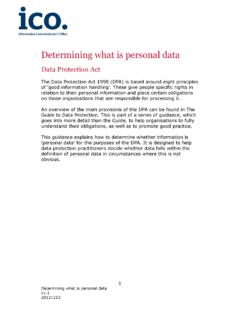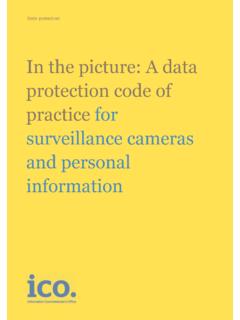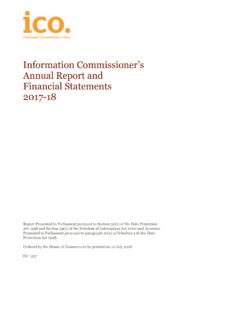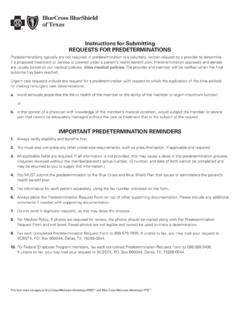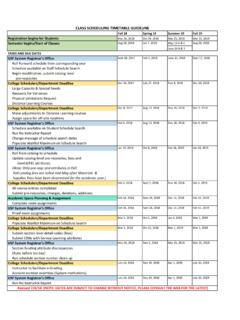Transcription of Dealing with vexatious requests (section 14) - Home | ICO
1 ICO lo Dealing with vexatious requests ( section 14). Freedom of Information Act Contents Introduction .. 3. Overview .. 3. What FOIA says .. 4. Application of section 14(1) .. 5. The meaning of vexatious .. 6. Identifying potentially vexatious requests .. 7. Dealing with requests that are patently vexatious .. 9. Dealing with less clear cut cases .. 10. Determining whether the request is likely to cause a disproportionate or unjustified level of disruption, irritation or distress .. 10. Assessing purpose and value .. 11. Considering whether the purpose and value justifies the impact on the public authority .. 13. Taking into account context and history .. 15. Burdensome requests .. 17. requests where collating the requested information will impose a significant burden .. 18. requests which would impose a grossly oppressive burden but are not covered by the section 12 cost limits .. 19. Round robins .. 21. Random requests and fishing' expeditions.
2 21. vexatious requests for published information .. 23. Campaigns .. 23. Recommended actions before making a final decision .. 25. Alternative approaches .. 26. Allow the requester an opportunity to change their behaviour .. 27. Refer the requestor to the ICO's For the public' webpages.. 27. Provide advice and assistance for requests which are unclear .. 28. Refusing a request .. 28. What the ICO will expect from an authority? .. 29. Dealing with vexatious requests ( section 14). 20151218. Version: Gathering 29. The cut off point for evidence that a request is vexatious .. 30. Making a case to the ICO .. 30. More information .. 31. Annex of example tribunal decisions .. 31. Disproportionate burden .. 31. Reopening issues that have been resolved .. 31. Unjustified persistence .. 32. Volume of requests harassing to member of staff .. 34. Campaign taken too far .. 35. Justified persistence .. 36. vexatious when viewed in context.
3 37. 2. Dealing with vexatious requests ( section 14). 20151218. Version: Introduction 1. The Freedom of Information Act 2000 (FOIA) gives the public a right of access to information held by public authorities. 2. An overview of the main provisions of FOIA can be found in The Guide to Freedom of Information. 3. This is part of a series of guidance, which goes into more detail than the Guide, to help public authorities to fully understand their obligations and promote good practice. 4. This guidance will help public authorities understand when a request can be refused as vexatious under section 14(1) of the FOIA. Overview Under section 14(1) of the Act, public authorities do not have to comply with vexatious requests . There is no public interest test. section 14(1) may be used in a variety of circumstances where a request , or its impact on a public authority, cannot be justified. Whilst public authorities should think carefully before refusing a request as vexatious they should not regard section 14(1) as something which is only to be applied in the most extreme of circumstances.
4 section 14(1) can only be applied to the request itself and not the individual who submitted it. Sometimes a request may be so patently unreasonable or objectionable that it will obviously be vexatious . In cases where the issue is not clear-cut, the key question to ask is whether the request is likely to cause a disproportionate or unjustified level of disruption, irritation or distress. This will usually be a matter of objectively judging the evidence of the impact on the authority and weighing this against any evidence about the purpose and value of the request . The public authority may also take into account the context and history of the request , where this is relevant. 3. Dealing with vexatious requests ( section 14). 20151218. Version: Although not appropriate in every case, it may be worth considering whether a more conciliatory approach could help before refusing a request as vexatious . A public authority must still issue a refusal notice unless it has already given the same individual a refusal notice for a previous vexatious request , and it would be unreasonable to issue another one.
5 If the cost of compliance is the only or main issue, we recommend that the authority should consider first whether section 12 applies (there is no obligation to comply where the cost of finding and retrieving the information exceeds the appropriate limit). What FOIA says 5. section 14(1) states section 1(1) does not oblige a public authority to comply with a request for information if the request is vexatious . 6. The Freedom of Information Act was designed to give individuals a greater right of access to official information with the intention of making public bodies more transparent and accountable. 7. Whilst most people exercise this right responsibly, a few may misuse or abuse the Act by submitting requests which are intended to be annoying or disruptive or which have a disproportionate impact on a public authority. 8. The Information Commissioner recognises that Dealing with unreasonable requests can place a strain on resources and get in the way of delivering mainstream services or answering legitimate requests .
6 Furthermore, these requests can also damage the reputation of the legislation itself. 9. section 14(1) is designed to protect public authorities by allowing them to refuse any requests which have the potential to cause a disproportionate or unjustified level of disruption, irritation or distress. 4. Dealing with vexatious requests ( section 14). 20151218. Version: 10. The emphasis on protecting public authorities' resources from unreasonable requests was acknowledged by the Upper Tribunal in the case of Information Commissioner vs Devon County Council & Dransfield [2012] UKUT 440 (AAC), (28. January 2013) when it defined the purpose of section 14 as follows;. section 14 is concerned with the nature of the request and has the effect of disapplying the citizen's right under section 1(1) The purpose of section 14 must be to protect the resources (in the broadest sense of that word) of the public authority from being squandered on disproportionate use of FOIA ' (paragraph 10).
7 11. This being the case, public authorities should not regard section 14(1) as something which is only to be applied in the most extreme circumstances, or as a last resort. Rather, we would encourage authorities to consider its use in any case where they believe the request is disproportionate or unjustified. Application of section 14(1). 12. It is important to remember that section 14(1) can only be applied to the request itself, and not the individual who submits it. An authority cannot, therefore, refuse a request on the grounds that the requester himself is vexatious . Similarly, an authority cannot simply refuse a new request solely on the basis that it has classified previous requests from the same individual as vexatious . 13. section 14(1) is concerned with the nature of the request rather than the consequences of releasing the requested information. If an authority is concerned about any possible prejudice which might arise from disclosure, then it will need to consider whether any of the exemptions listed in Part II of the Act apply.
8 14. Public authorities need to take care to distinguish between FOI. requests and requests for the individual's own personal data. If a requester has asked for information relating to themselves, the authority should deal with the request as a subject access request under the Data Protection Act 1998. 15. You can read our guidance on how to handle a subject access request here. 5. Dealing with vexatious requests ( section 14). 20151218. Version: The meaning of vexatious 16. In Information Commissioner vs Devon County Council &. Dransfield [2012] UKUT 440 (AAC), (28 January 2013) the Upper Tribunal took the view that the ordinary dictionary definition of the word vexatious is only of limited use, because the question of whether a request is vexatious ultimately depends upon the circumstances surrounding that request . 17. In further exploring the role played by circumstances, the Tribunal placed particular emphasis on the issue of whether the request has adequate or proper justification.
9 They also cited two previous section 14(1) decisions where the lack of proportionality in the requester's previous dealings with the authority was deemed to be a relevant consideration by the First Tier Tribunal. 18. After taking these factors into account, the Tribunal concluded that vexatious ' could be defined as the manifestly unjustified, inappropriate or improper use of a formal procedure.' (paragraph 27). 19. The Tribunal's decision clearly establishes that the concepts of proportionality' and justification' are central to any consideration of whether a request is vexatious . 20. 20. At the subsequent Court of Appeal Case (Dransfield v Information Commissioner and Devon County Council [2015]. EWCA Civ 454 (14 May 2015)), Lady Judge Arden observed that;. the emphasis should be on an objective standard and that the starting point is that vexatiousness primarily involves making a request which has no reasonable foundation, that is, no reasonable foundation for thinking that the information sought would be of value to the requester or to the public or any section of the public.
10 (Para 68). 21. Whilst, on face value, the Judge's ruling might appear to suggest a higher test for vexatiousness, with more of an emphasis on the value of the request , we don't regard it as a departure from the position taken by the Upper Tribunal. This is because she also went on to say;. The decision maker should consider all the relevant circumstances in order to reach a balanced conclusion as to whether a request is vexatious .'. (Para 68)'. 6. Dealing with vexatious requests ( section 14). 20151218. Version: 22. This being the case, we would suggest that the key question the public authority must ask itself is whether the request is likely to cause a disproportionate or unjustified level of disruption, irritation or distress. Identifying potentially vexatious requests 23. It may be helpful to use the indicators below as a point of reference, as our experience of Dealing with section 14(1). complaints suggest that these are some of the typical key features of a vexatious request .
